Written by Lorrie Reynolds
Categories
A new agility puppy! How exciting! You have dreams about making this puppy your next agility star, but…how much is too much? What activities are safe? What things will help build good foundations and which skills should be left for later? Are you going to “miss out” on a critical period or flub a critical skill? Let’s break down some of these questions into actions.
Part 1 of the puppy series is 15 Things to Teach Your New Puppy. It describes the things that I teach every new dog that comes into my home, whether they are going to be future agility dogs or not. When it comes to agility, this article explains the things I teach my puppy (or rescue) when they first come home. I’ll also touch on what NOT to teach until the dog is more physically and/or mentally mature.
For those who prefer a list view, I’ve added it at the bottom of the article.
Follow Me!
Following my motion is something I teach unintentionally (we all do) and intentionally. We unintentionally teach our dogs to follow us because we provide access to things they want – the food bowl, the door to go outside, and the treat jar, to name a few. Most puppies also want to be in the same room as the rest of their “family” so they follow us from room to room. I pair this unintentional learning with intentionally teaching the puppy how to follow my motion in a straight line, circle, and through turns.
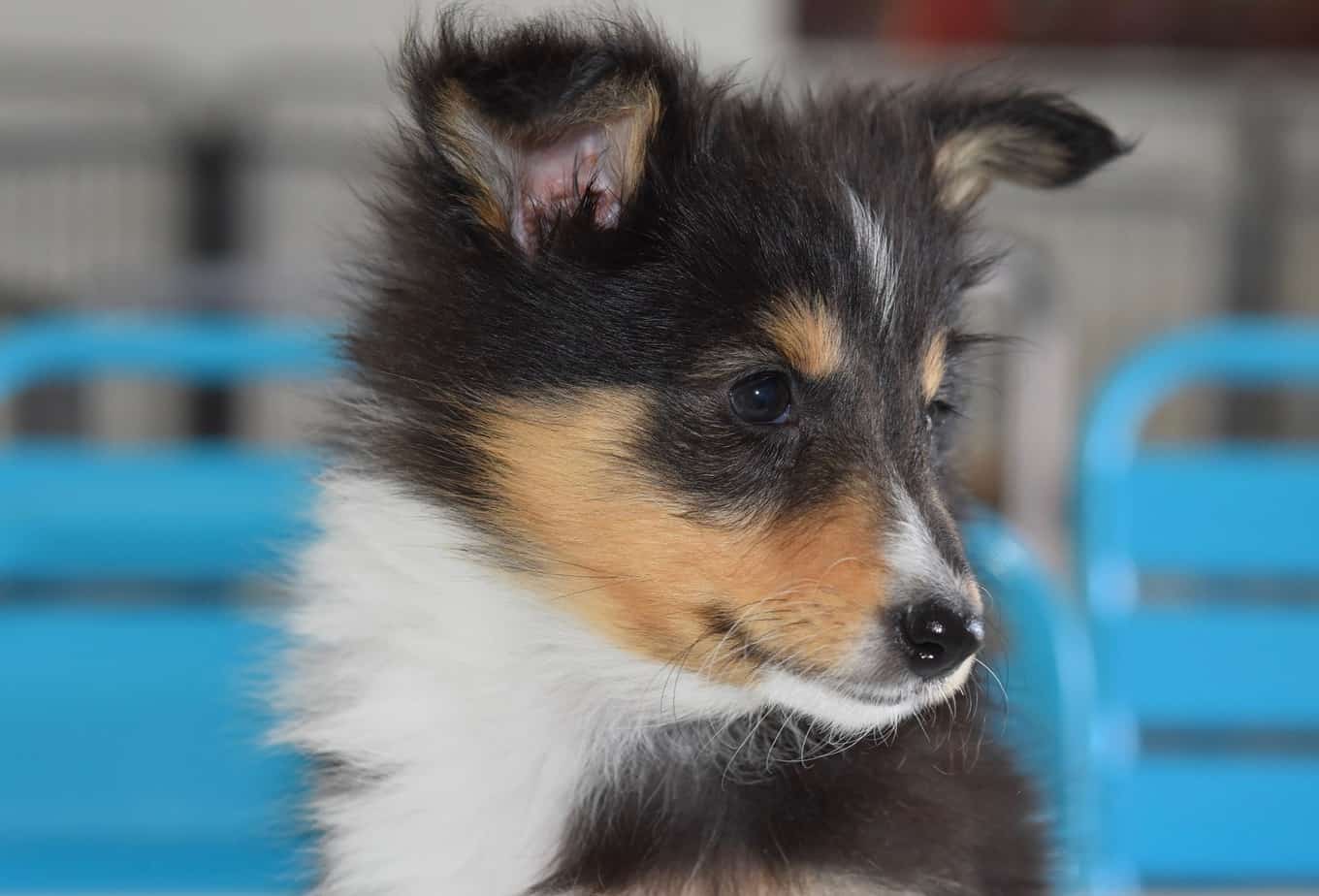
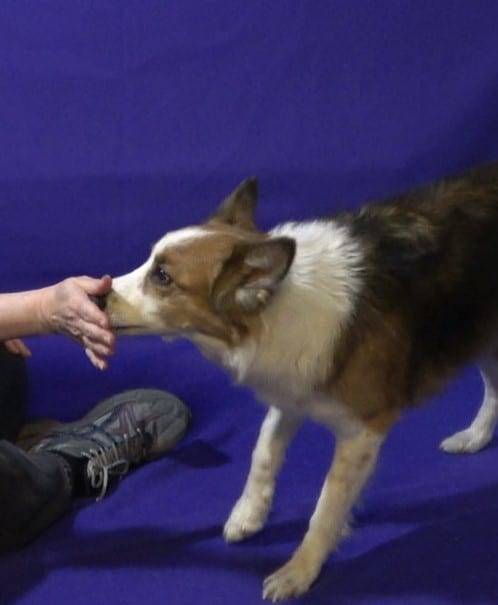
Nose to Hand
I like to develop my puppy’s interest in following/touching my hand (without biting) as part of my foundation. This helps when we start working on things like lining up and front crosses. Having a puppy who can be positioned at your side or in front of you by using a nose touch is very useful. Teaching the dog to follow your hand as a target helps guide movement to the correct side of your body when performing crosses.
Find My Side
Speaking of lining up, one of the skills I teach that makes my life much easier is teaching the dog to find my side (right or left). This is similar to teaching the heel position, but without the strict positioning that will come later with formal heeling. There are so many things that can be made easier to teach by having a dog that will find your side. Lining up for an exercise or at the start line, loose leash walking, and staying out from underfoot are three of the best reasons to teach it (and making photo taking easy is a side benefit). Having dogs that would move to my side instead of in front of me helped immensely when I had to put in time on crutches after knee surgeries.
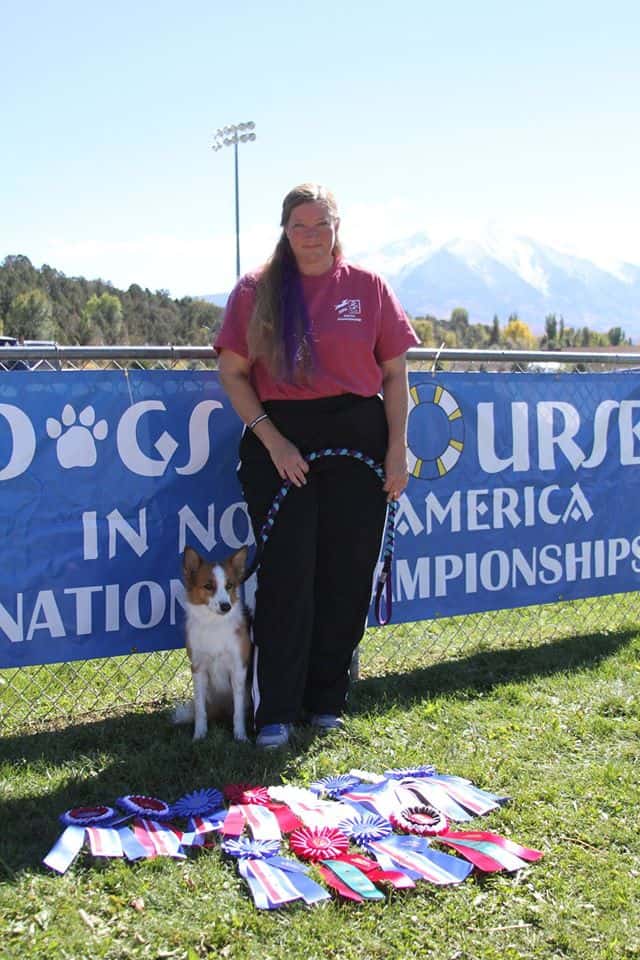
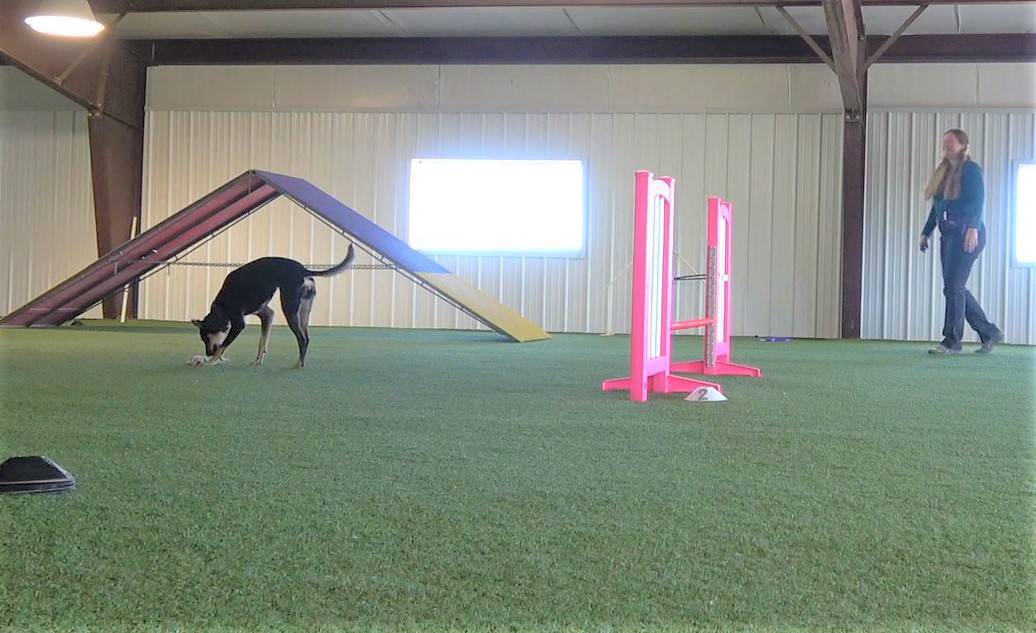
Targeting
We want our dogs to perform obstacles independently, and should teach them to perform each obstacle without help, but sometimes when we practice, we need a little extra direction, motivation, or speed. Teaching a dog to run to a target (baited or not) gives us a useful tool to help them figure out specific skills. Note that I do NOT use a target that encourages them to drop their heads for contact training since it shifts the dog’s weight forward, which is the opposite of what I like to see for safe contact performance – one of the many changes I’ve made to my training philosophy over the years as I’ve increased my knowledge.
Go to Mat
Because I teach stopped contacts (with a quick release once they are fully proficient), one of my training tools is a small mat or foam square. Depending on my end goal (2 on/2 off or 4 on the floor), I teach a sit or a down on the mat. My dog learns to run to the mat and sit or lie down, regardless of my position relative to the dog or the mat.
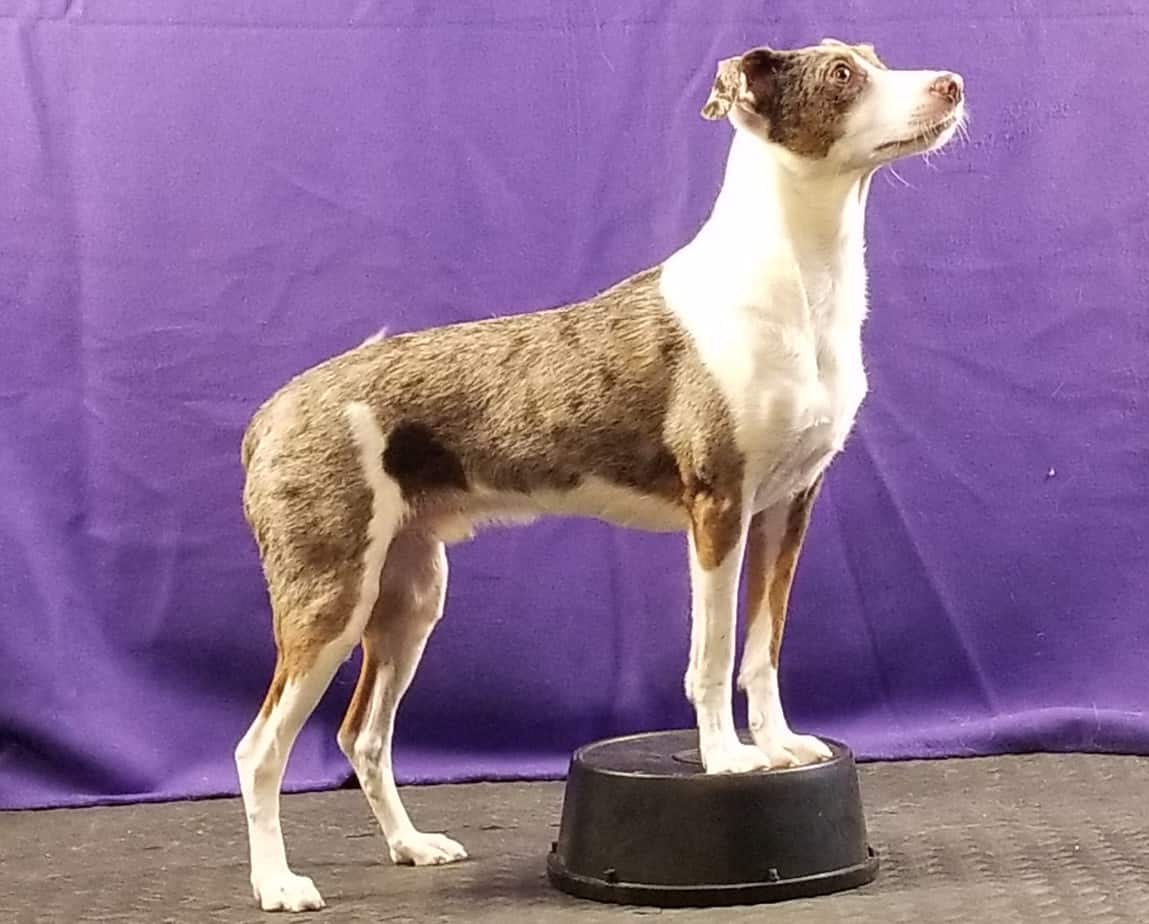
Paws on a Bucket
For conditioning and as a tool to help with stays and control at the end of an exercise, I use a “mark bucket” – an overturned rubber feed pan – that that dog will drive to, put his paws on, and wait. This is useful in conditioning for the side-step drill (rear end awareness) and in sequences as a starting and/or ending point that helps with self-control.
Release Cue
Over the years, I’ve moved from teaching a stay with body pressure, stern cues, and neutral repositioning if they “break” to teaching a release cue as a fun game that encourages the dog to fully participate in waiting and to anticipate the release cue as something fun. It significantly changes the game from one that is not very fun with “mistakes” to a game that the dog loves and gets another chance to succeed at if they move. It has made teaching the stay (or release) much more enjoyable for both me and my dogs.
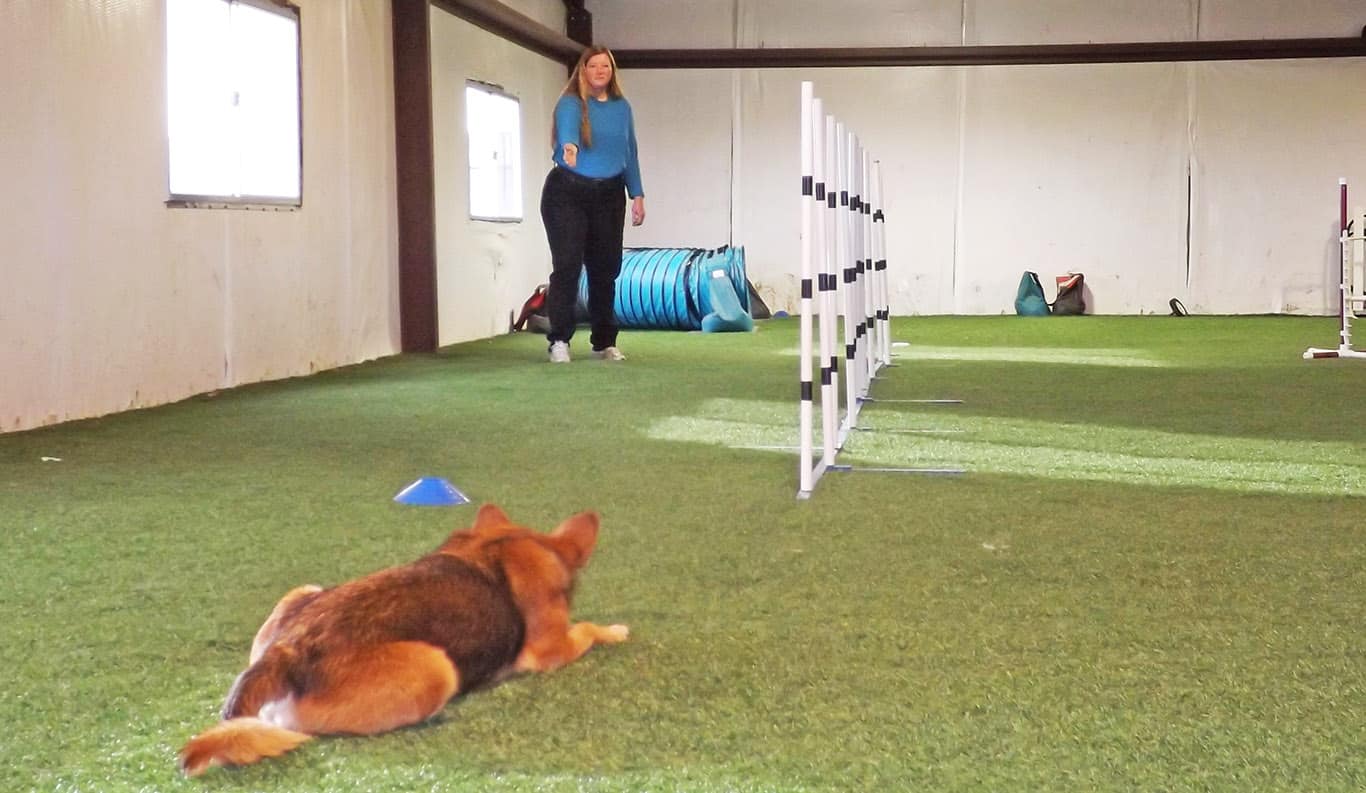
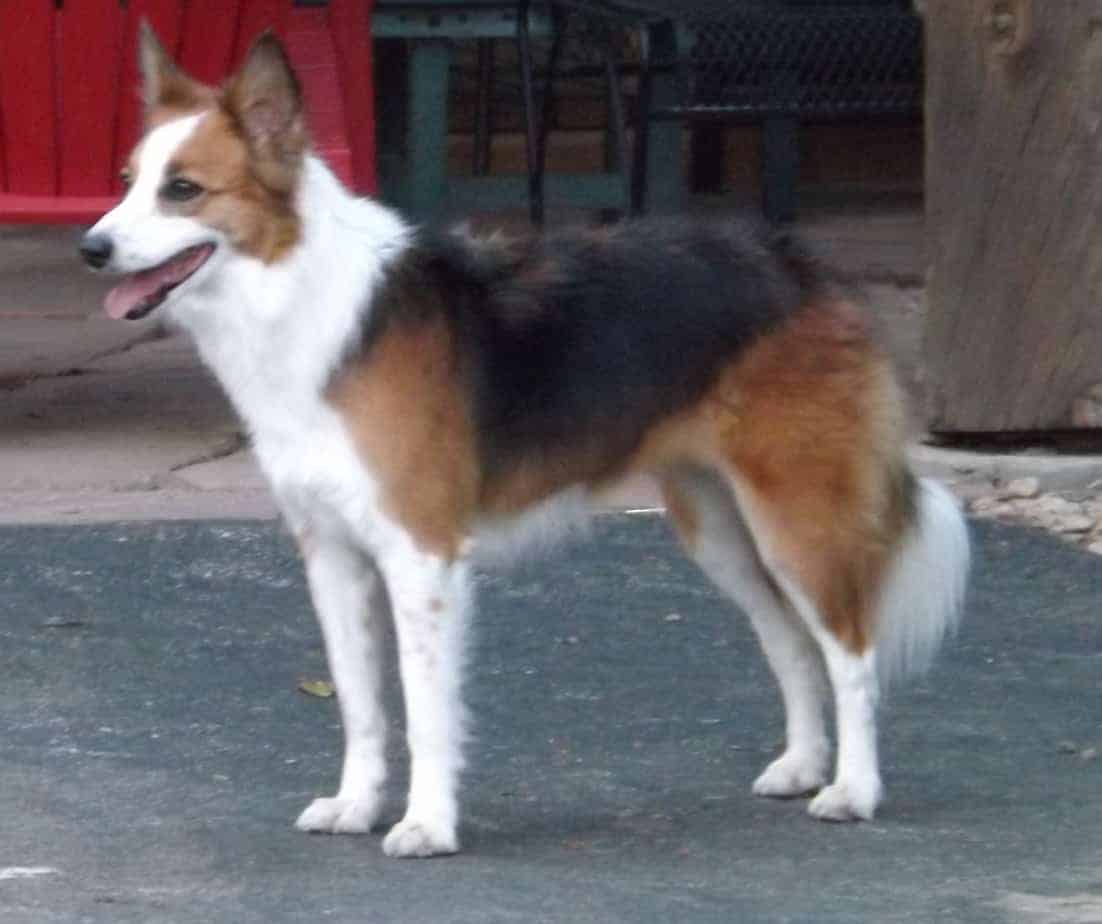
Moving Wait
Another fun game that I teach my dogs is the moving wait. It is used both for safety and (very occasionally) for agility. Being able to tell my dog to wait if I see a squirrel or a loose dog coming so I can react gives me peace of mind. Also, although I’m not an advocate of fixing things on the agility course, occasionally, if you catch the dog before they commit to an obstacle and have a wait that has been taught as a fun game, it is possible to proactively fix the dog’s path without demotivating them by stopping the game.
Spin/Turn Away/Rear Cross
I teach new puppies the foundations for the rear cross and turn away at a distance, but only practice it in moderation since it is an exercise that could put some strain on growing bodies if done in excess. The sequence for learning is spin (both directions), then walking spin (turn while walking in one direction), spin with the handler turning 180 degrees, and finally a rear cross using a single jump upright, cone or barrel. These small handling foundations have a large payoff when I start working with equipment.
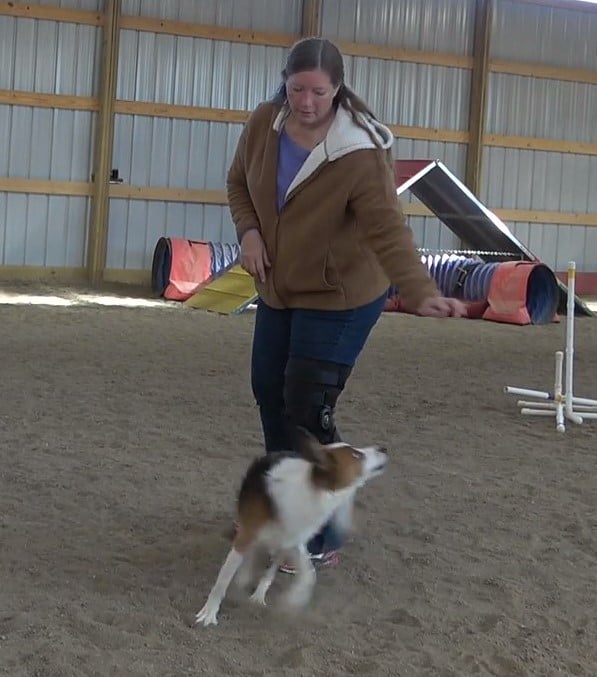
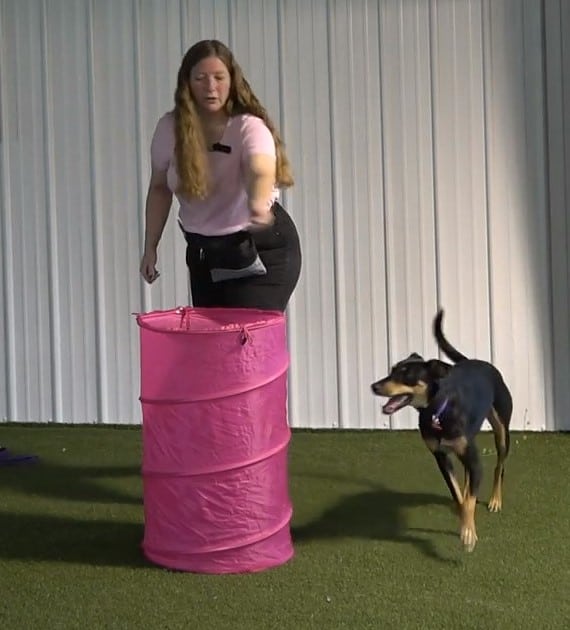
Barrel and Cone “Wraps”
Two of the tools I use for a variety of skills are a barrel and a cone. For puppies, I don’t focus on creating tight turns, which is why the word “wraps” is in quotation marks. Teaching a dog to go to a cone or barrel and go around it can be used for forward distance, lateral distance, rear crosses, and a number of other exercises. If the puppy learns that going around a cone or barrel is rewarding, it is much easier to work on those higher-level skills like distance when they are older.
Here and Out
Puppies are easily able to learn the body cues for moving toward the handler and away from the handler. This helps with discriminations later on when they are old enough for obstacles. I use a barrel or cone to help them understand the “out” cues and flatwork to teach them “here” cues.
Rear End Awareness
Rear end awareness is a crucial skill for agility dogs that helps them navigate contacts, place their feet for weave poles, and negotiate tight turns. Although extensive conditioning is not appropriate for very young dogs, puppies can learn some basic rear end awareness skills like putting their back feet on a fit disc or similar object, backing up, and walking through a ladder on the ground, among others. Any conditioning exercises should be done in moderation with young dogs and with an awareness of appropriate challenges based on their age.
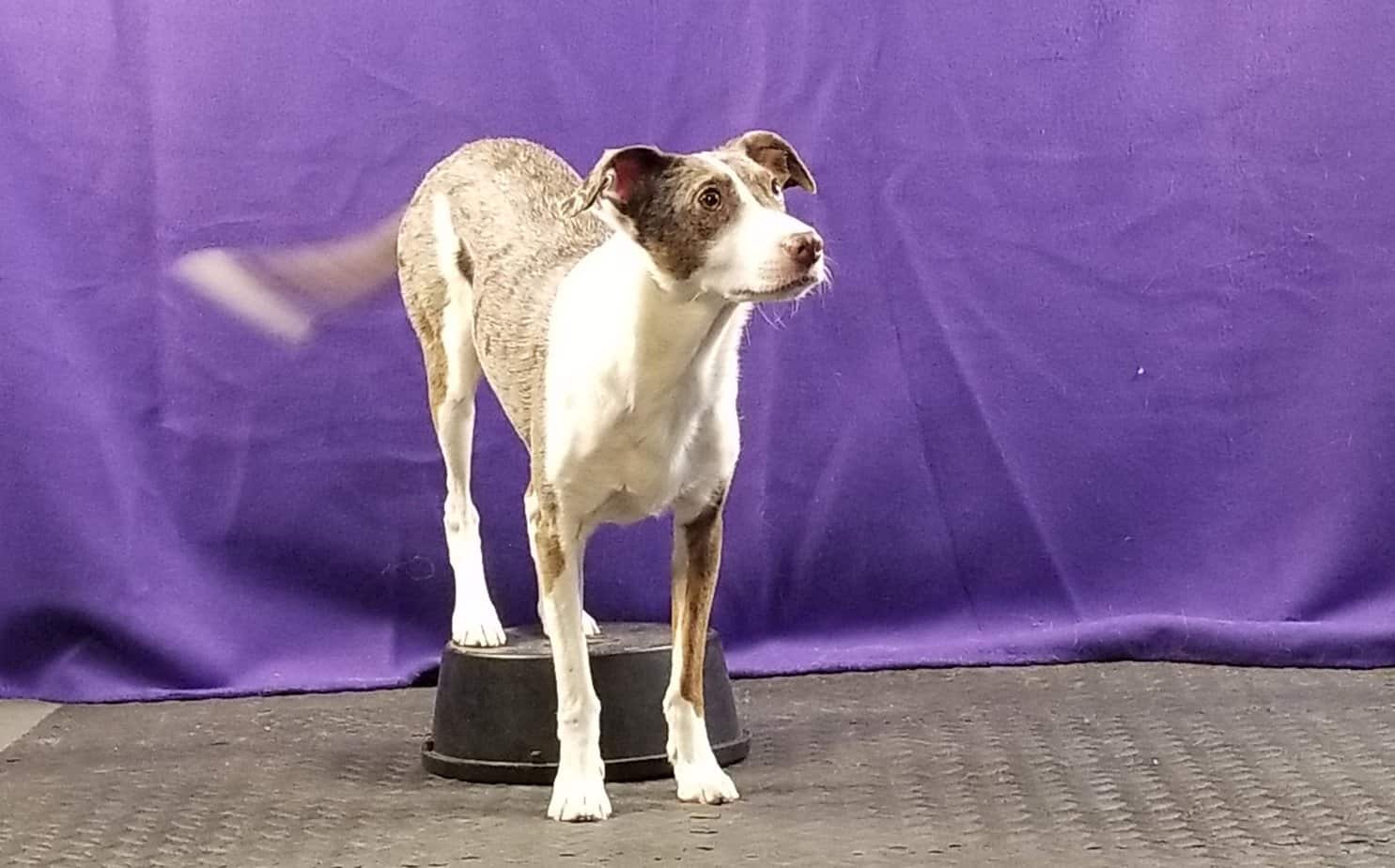
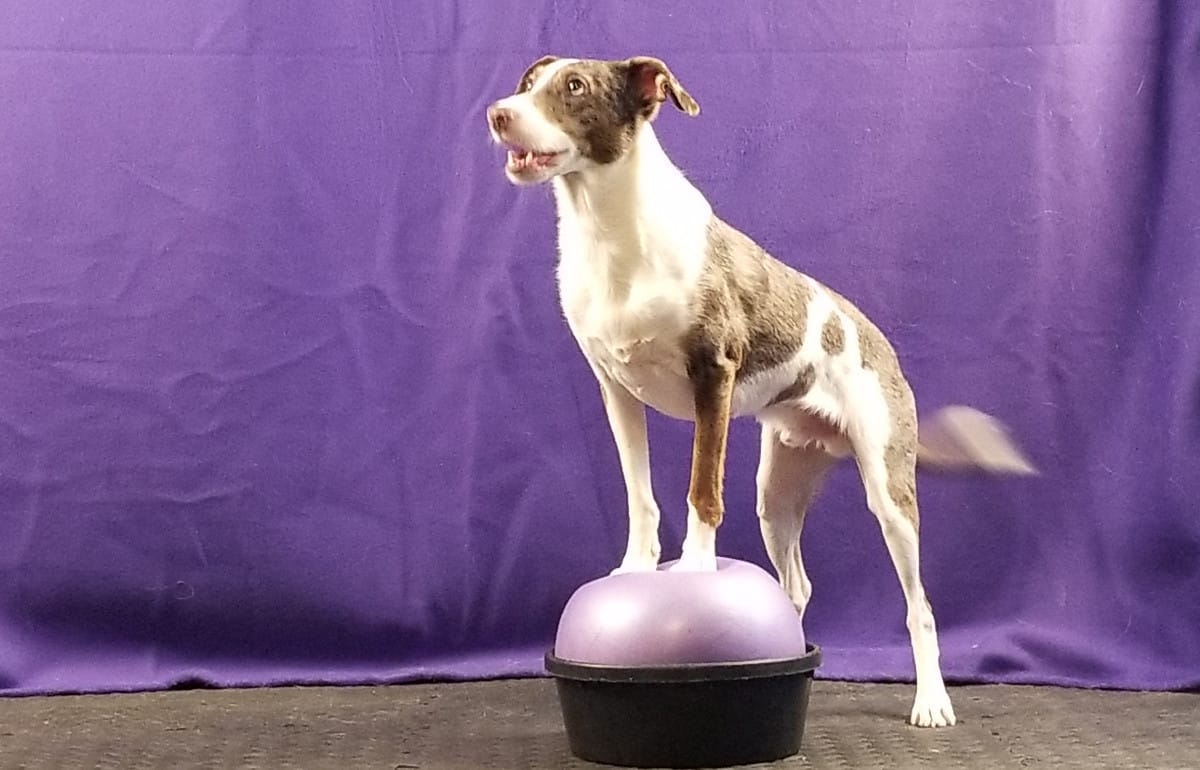
Paws on a Fit Disc or Similar Object
Teaching puppies to place their paws on a fit disc or similar object serves three purposes. It helps them get used to something moving under their feet, it aids in developing balance, and it builds muscle used for stabilizing their bodies. This is another exercise that should not be done with very young puppies, and should be done in moderation until they are more mature.
Wobble Board
Like the fit disc, the wobble board encourages a puppy to be unconcerned about something moving under his feet, helps develop balance, and builds muscle. Walking across a wobble board and moving on it as it rebalances is a great first step for teaching the teeter when they are older. This should be done in moderation, and the pivot point under the board should be low enough that there is no danger of a significant drop that could injure growing joints.
Jump Uprights
Even very young puppies can learn to identify and go through jump uprights with no bar. They should not be asked to make sharp turns before or after the uprights. Training uprights in the initial stages should be an extremely fun game where they find the correct opening and are immediately rewarded with a click and treat or toy. Fostering independence at an early age will help ensure that the dog will seek out the uprights when more advanced training starts.
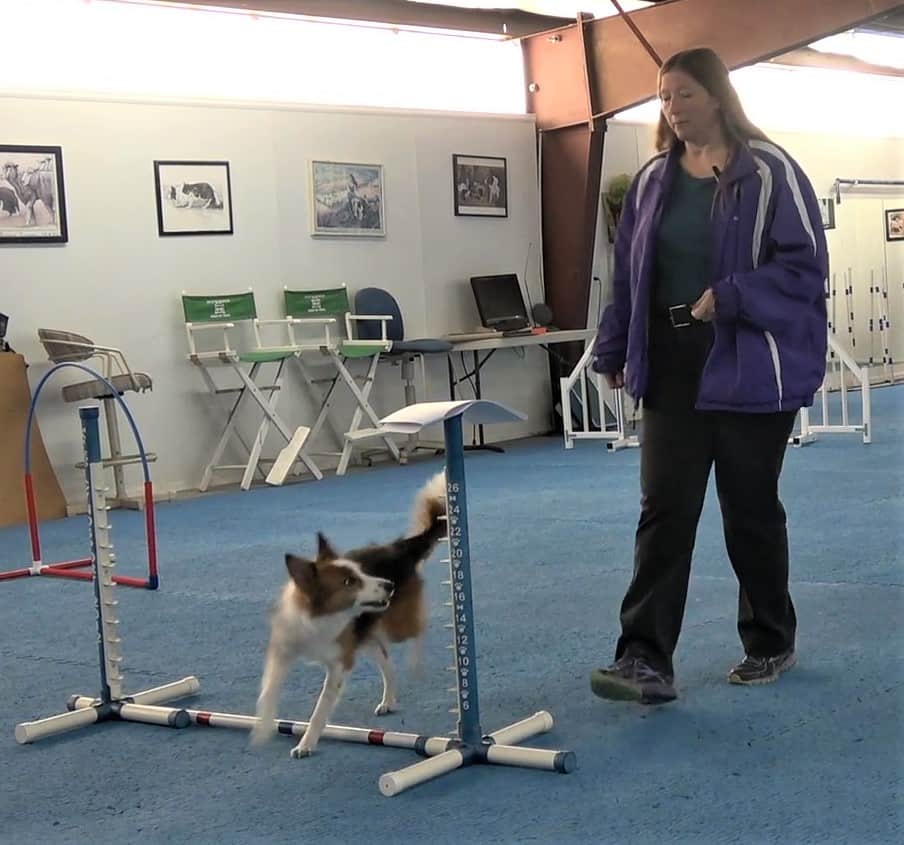
Blind Cross Basics
The final skill that all puppies should know is the basics of a blind cross, or switching sides behind the handler. I teach this entirely through flatwork in the beginning stages, and since it is natural for a dog to come to the side you are looking to, it is an easy first-step exercise for them to learn and enjoy.
What I Don’t Teach Puppies
Puppies do not have the physical or mental maturity to learn weave poles, contacts, jumps, or tight turns. All of these activities can cause permanent damage to bones and joints before the growth plates close. Growth plate closure occurs at different times for different breeds and sizes of dogs, with smaller dogs maturing a bit earlier than large dogs. There are also individual differences between dogs of the same size. In GENERAL, growth plates close at about 12 months on small dogs, and about 18 months for large dogs, at which point, you can start teaching more physically demanding skills. HOWEVER, since there is so much variation between individuals, the best thing to do is consult with your veterinarian about when those activities are safe for your specific dog.
Puppy Agility Skills List
To recap, here is a list of skills I teach to my new puppies or rescue dogs:
-
- Following your motion
- Hand touches
- Find my side
- Targeting
- Go to Mark
- Paws on a Bucket
- Release Cue
- Moving Wait
- Spin/Turn Away/Rear Cross
- Barrel and Cone “Wraps”
- Here/Out
- Rear End Awareness
- Fit Disc
- Wobble Board
- Jump uprights
- Blind cross basics
There are many, many things you can teach to future agility stars that are safe and will get them off to a great start. Spend time now on the foundations and save yourself frustration in your future training. Above all, enjoy the journey with your new companion. They don’t stay puppies for long.
If you enjoyed this article, please share it with a friend. For freebies, news, tips, discounts and upcoming course announcements, sign up below!
You Might Also Like…
Five Ways to Crush It at Your Next Dog Agility Seminar
Going to a dog agility training seminar? Check out these five tips to maximize your return on investment!
Read This Before Deciding on Your Agility Dog’s Contact Performance
Which contact performance, running or stopped, is right for your team? The answer might surprise you.
Is Your Agility Dog a Pinto or a Ferrari?
If you’ve moved up from a slow or moderately-fast agility dog to a speed racer, here’s some advice to make your life easier.
Get tips, stories, discounts, and early notification of events and new courses delivered straight to your inbox! Join the community!
Top photo: Copyright 2018 Great Dane Photos. Used with permission.
Second photo courtesy of Howling Moon Photography.
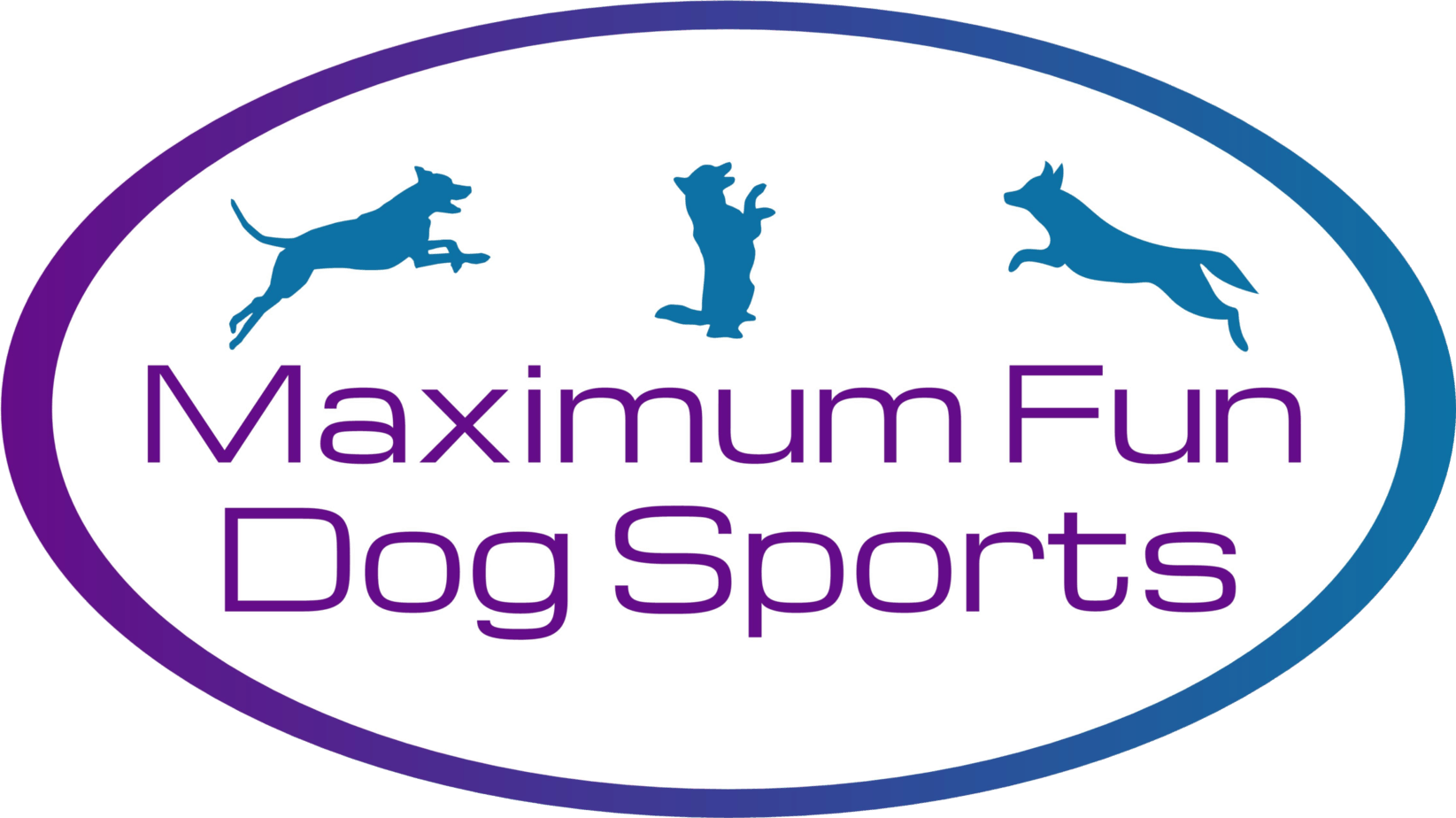
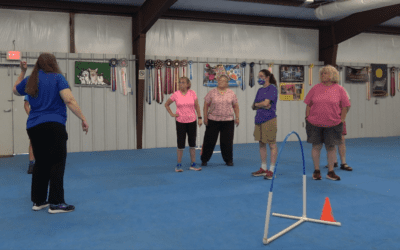
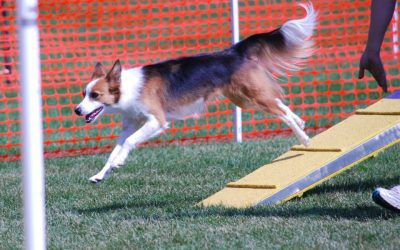
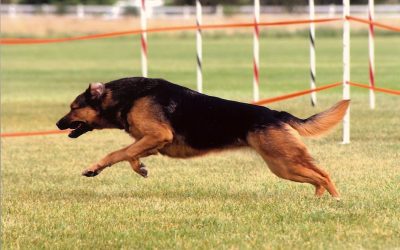
0 Comments